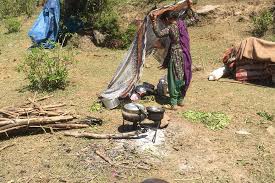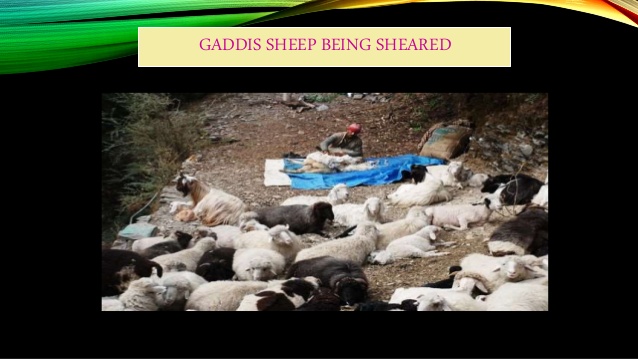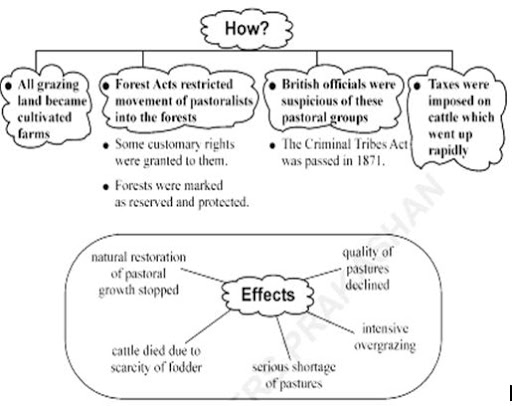| Pastoralists in The Modern World I |
Gujjar BakarwalsPastoralism has been important in societies like India and Africa for years. Pastoralism is a way of keeping animals such as cattle, sheep that involves moving from one place to another to find water and food. Nomads are people who do not live in one place, but move from one area to another to earn their living. In many parts of India we can see nomadic pastoralists which move with their herds of goats and sheep , or camels and cattle. Movement of Pastoral Nomads in Mountains: Mainly pastoral communities are found in mountaineous regions. There are some reason Nomadic tribes need to move from one place to another: The nomadic tribes had no regular fields of their own from where to get fodder for their animals, so they had to move from one place to another in search of pastures.In the hilly hilly areas, they lived with their herds in the low hills of the Himalayas from September to April because the huge mountains were covered with snow.The dry scrub forest provided pastures for their herds during this period (September to April). When this source was exhausted they were on the move again.With the onset of the summer, when the the snow melted and the hill sides were covered with lush green with a variety of new grasses , the pastoralists (in the beginning of April), began their northern march for their summer grazing grounds.When again , the mountains covered with snow and there was dearth of nutritious forage, they were on the move again, this time on their downward journey.Advantages to the Environment of their Continuos Movement : The movement of the nomadic pastoralists from the downward to the upward areas and from the upward areas again to the downward areas proved very advantageous to the environment.These movement allow sufficient time for the natural restoration of vegetation grounds.This continuous shifting provided sufficient forage to the different animals both at the high mountains and the lower hills.They helped in maintaining the quality of the pastures.GUJJAR BAKARWALS OF JAMMU AND KASHMIR : The Gujjar Bakarwals of Jammu and Kashmir belong to the nomadic people who in search of pastures for their animals (goat and sheep) go on migrating from one place to another In summer , when the snow melted in the mountains and mountain sides were lush green, they moved on to the high levels.The variety of sprouted grass provided rich nutritious forage for their animals herds.As soon as the winter came and the high mountains with snow again , they came down to the low hills of the Shiwalik hills and stayed there with there herds.So every year, they moved annually between their summer and winter grazing grounds.They continued year after year.
|
Gaddi ShepardsGaddi Shepherds: Gaddi shepherd is a pastoral community of Himachal Pradesh. They had a similar cycle of seasonal movements like Gujjar Bakarwals of Jammu and Kashmir. Movement of Gaddi Shepherds: During winter, Gaddi Shepherds grazed their flocks in scrub forests of the low hills of Siwalik range. By April, they moved North and spent the summer in Lahul and Spiti. Further to the East, in Garhwal and Kumaun, the Gujjar cattle herders came down to the dry forests of the bhabhar in the winter and went up to the high meadows—the bugyals in summer.Many of the Gujjar cattle herders were originally from Jammu and Kashmir and came the to up hills in the 19th century in search of good pastures. When the snow melted on the high mountains, they moved onto higher mountain meadows (dhars).By September, they began their return movement. On way, they stopped once again in the villages of Lahul and Spiti, reaping their summer harvest and sowing their winter crop. On the way down, they stop for a while to have their sheep sheared.The sheep are bathed and cleaned before wool is cut. Uhl valley near Palampur in Himachal Pradesh is one of the areas where shearing of wool is being done. Then, they further descend to their winter base - the Shiwalik Hills.
|
Bhotiyas Sherpas and KinnaurisBhotiyas, Sherpas and Kinnauris: The pattern of cyclic movement between summer and winter pastures was typical of many pastoral communities of the Himalayas , including the Bhotiyas , Sherpas, Kinnauris.All of them had to adjust to seasonal changes and make effective use of available pastures in different places.when the pastures was exhausted or unusable in one place they moved their herds and flocks to new areas .This continous movement also allowed the pastures to recover; it prevented their overuse.Movement of Pastoral Nomads on the Plateaus, Plains and Deserts: The pastoral communities are also found in the plateaus, plains and deserts of India |
DhangarsDhangars: Dhangars were an important pastoral of Maharastra. Some of them were buffalo headers while others were shephards and still others were engaged in weaving of jobs, especially in blanket weaving.During monsoon, the dhangars shepherds stayed in central plateau of Maharashtra which was a semi - arid area with poor soil and low rainfall.They cultivated a dry crop like bajra and tended their flock on the thorny scrub grown there.In October, when they had reaped bajra crop , they started their journey westwards to kolkata where they and their flock was welcomed by the Konkan peasants. It was give and take reaction.The Dhangars flocks were fed on the suitable (or green stalks) left after the kharif harvest and in return, their flock manured the fields of the konkan peasants.With onset of the monsoon in the konkan and the coastal areas, the dhangars marched back of their dry sojourn in the central plateau of Maharastra.So the dhangars of the Maharashtra also had to go through the cycle of the seasonal movements. |
The Gollas Kurumas and KurubasThe Goltas, Kurumas and Kurubas: The Gollas, Kurumas and Kurubas are the important pastoral communities of the dry central plateau of Karnataka and Andhra Pradesh. The Gollas herded cattle. The Kurumas and Kurubas reared sheep and goats and sold woven blankets. They lived near the forests, cultivated small patches of land, engaged in a variety of small trades and took care of their herds. The movement of these pastoralists, depended monsoon and dry season. In the dry season, they moved to the coastal tracts and left when the rains came. Only buffaloes liked the swampy, wet conditions of the coastal areas during the monsoon months. Other herds had to be shifted to the dry plateau at that time. |
Banjara TribesBanjara Tribes: They were an important group of graziers, which were found in the villages of Uttar Pradesh, Punjab, Rajasthan, Madhya Pradesh and Maharashtra. In search of good pasture land for their cattle, they moved over long distances. They sold their plough cattle and other goods to villagers in exchange of grain and fodder. |
RaikasRaikas: They lived in the deserts of Rajasthan. Before 1947, they used to migrate to Sindh and grazed their animals on the banks of the Indus. But after partition, when Sindh became a part of Pakistan, this activity was restricted. Now, they started migrating to Haryana where sheep can graze on agricultural fields after the harvest. The rainfall in the region was less and uncertain. So, they combined cultivation with Pastoralism. During the monsoon, the Raikas of Barmer, Jaisalmer Jodhpur and Bikaner stayed in their home villages, where pasture was available. By October, when those grazing grounds were exhausted, they moved out in search of new pastures. They returned in their home villages during the next monsoon. Maru Raikas: One group of Raikas was known as Maru Raikas who reside in the Thar Desert near Jaisalmer, Rajasthan. Their settlement is called a dhandi. They herded camels and another group reared sheep and goat. Maru Raikas know the history of their community from genealogist. The genealogist is the one, who recounts the history of tribes. Such oral traditions give pastoral groups their own sense of identity. Camel Fairs: The camel fairs are held at different places of Rajasthan such as Pushkar, Balotra, etc. Camel herders come to the fair to sell and buy camels. The Maru Raikas also display their expertise in training their camels. Horses from Gujarat are also brought for sale at this fair. |
Factors That Contributed of Movement of PastoralistsFactors that Contributed of Movement of Pastoralists: The life of pastoral groups is not easy. It was sustained by a careful consideration of a host of factors are as follows: They had to judge when and where to move otherwise both they and their herds could have been starved.They had to judge how long the herds could stay in particular area.They had also to know where they could find both pastures and water.They had to calculate the timings of their movements so that green grasses and nutritious forage are available to their herds.They had to make an estimate of the terrains they had to pass during their seasonal movements.Above all, they had to combine different activities - like herding cultivation and trading etc. for their survival.Colonial Rule and Pastoral Life: The Colonial Government made different laws from time to time which severely affected the lives of the pastoralists. Their grazing grounds shrank, their movements were regulated, they had to pay high revenue, their agricultural stock declined and their trades and crafts were also affected adversely. The colonial power believed that all grazing lands were wastelands because they were unproductive. These lands did not produce revenue or agricultural products. From the mid - 19th century, Wasteland Rules were enacted in various parts of our country. The colonial rulers put so many hurdles in the way of the pastoralists. As such the pastroralists had to adopt new method to survive: Since the availability of pastures was limited, so some of the pastoralists reduced the number of cattele in their herds.Others tried to find or discover new pastures elsewhere.Certain pastoralists, like the Raikas of Rajasthan, migrated to haryana where their sheep could graze on agriculture fields after the harvest are cut. Formerly, before 1947 , they used to migrate to sind , but with the partition of the country ,they could no longer go to sind, which had become a part of Pakistan. Their herds provided the manure which the fields require afresh foe new crops to grow.Some pastroralists combined pastrol activity with same other activities like weaving blankets and trading.So the adopting the above methods , the pastoralists have survived to this day. According to many scientist and ecologists in the dry and mountain regions pastrolism is still ecologically the most viable from of life. |
Wasteland Rule and Forest ActWasteland Rules and Forest Acts: The government granted selected individuals various concessions and encouraged to settle them in these areas. Even some of them were made as headmen of villages. In most areas, the lands taken over were actually grazing tracts used regularly by pastoralists as their customary rights.They believed that grazing destroyed the saplings and young shoots of trees that germinated on the forest floor.The herds crushed the saplings and munched away shoots. These prevented new trees to grow.The Forest Acts made by the British Government changed the lives of pastoralists. Some forests which produced commercially valuable timber like deodar or sal were declared as reserved.In the reserved forests, no pastoral activity was allowed and in the protected forests their activity was strictly restricted. In the protected forests, they needed a permit for entry. The permit specified the timing of their entry and departure. If they overstayed there, they were liable to fines.EFFECTS OF WASTELANDS RULES: All grazing lands were considered as wastelands by the colonial rulers as they brought no revenue to the government. So the government passed wastelands rules as a result of which all the uncultivated lands (including grazing lands) were taken over and handed over to select individuals. As a result of which the pastures vanished like anything within no times which created a lot of problems for the pastrolists. |
Criminal Tribes ActThe Criminal Tribes Act was one of the many laws passed by the British colonial government that applied to Indians based on their religion and caste identification. The Criminal Tribes Act and its provisions used the term Tribes, which included castes within their scope. Criminal Tribes Act: British officials were very suspicious of nomadic people. They wanted to rule over a settled population which could be easily identified and controlled. In 1871, the British Government in India passed the Criminal Tribes Act. By this act, many communities of craftsmen, traders and pastoralists were classified as Criminal Tribes. EFFECTS OF CRIMINAL TRIBES ACT : They were stated to be criminal by nature and birth.As a result of this act, these communities were expected to live only in notified village settlements and they were not allowed to move without a permit.The village police also kept a strict watch on them.This gave death blow to the moving activities of the nomadic people. |
Imposing of Grazing TaxImposition of Grazing Tax: In the mid—19th century, Grazing Tax was introduced by British Government in most pastoral lands of India. In order to increase income, the government imposed tax even on animal. The tax per head of cattle went up rapidly and the system of collection was made increasingly efficient. In the decades between the l850s and 1880s, the right to collect the tax was carried out by contractorsThese contractors tried to extract high tax, so that they could earn profit. By the l88o's , the government began collecting taxes directly from the pastoralists. Each of them was given a pass. The pastoralists had to pay tax on every animal they grazed in the pastures.To enter a grazing tract, the pastoralist had to show the pass and pay the tax.
|
 |








